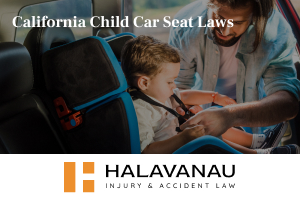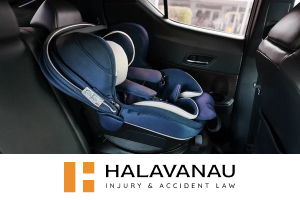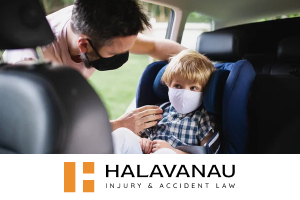
At Halavanau Injury and Accident Law, we understand the importance of these regulations and how they can impact the safety of children on the road. There are height and weight limits for both rear-facing car and forward-facing car seats. Review the regulations if you have questions about when your child can be in a forward-facing car seat. Then, ensure you know when your child can move from the rear seat to the front seat. You must make sure your child is protected in the event of a car accident.
Learn more below. Then, contact us to schedule a consultation.
In California, the law requires that all children under the age of eight must ride in an appropriate car seat or booster seat in the back seat of a vehicle. The safest place for this seat is in the middle back passenger seat. Children eight years old or have reached 4'9" in height can use a booster seat or a safety belt. These laws are in place to ensure the utmost safety for young passengers in any vehicle. California Vehicle Code Section 27360 mandates these requirements, focusing on enhancing child safety.

Selecting the correct type of car seat is critical for a child's safety. The exact seat type will depend on the child's height, weight, and age.
Rear-facing infant seats are designed for newborns and small babies. These seats offer the best protection for infants' spine, head, and neck if a collision occurs. It's recommended that babies ride in these seats until they reach the highest weight or height allowed by the seat's manufacturer. Switching to a forward-facing seat too soon can increase the risk of injury.
Once a child outgrows their rear-facing seat, they should transition to a forward-facing toddler seat. These seats have a five-point harness and tether that limits a child's forward movement during a crash. The American Academy of Pediatrics recommends that children use these seats for as long as possible until they reach the maximum height or weight limit allowed by the seat. Forward-facing seats provide crucial protection for growing children.
When children are too large for forward-facing seats, they can move to booster seats. These seats raise a child high enough to ensure that the car's seat belt fits properly over their body. The seat belt must fit snugly over the child's upper thighs, not the stomach, and across the chest, not the neck. Booster seats go in the rear seats of vehicles.
California's child car seat laws are comprehensive, covering various aspects of child safety in vehicles.
A. Age and Weight Requirements
In California, children under two must use a rear-facing car seat unless they weigh 40 pounds or more or are 40 inches tall. The rear-facing position is the safest for young children, as it better supports the head, neck, and spine. It's essential to check the car seat manufacturer's weight and height limit guidelines. Keeping a child in a rear-facing seat as long as possible within these limits is recommended for optimal safety.
B. Exceptions
Exceptions to the rear-facing requirement are rare and typically based on specific medical conditions or physical limitations. Parents or guardians must have a licensed physician's signed note explaining the exception's reason in these cases. Following all guidelines and consult with a medical professional before changing your child's car seat arrangement is crucial.
A. Age and Weight Requirements
Once children outgrow the rear-facing seat's maximum weight or height limits, they can transition to a forward-facing seat. California state law generally recommends that children remain in a forward-facing seat with a harness until they reach the age of eight or are 4'9" tall. The key is to ensure that the child fits within the manufacturer's specified weight and height limit for the seat.
B. Exceptions
Exceptions to forward-facing seat requirements are minimal and should only be considered under exceptional circumstances, such as certain medical conditions. As with rear-facing seats, any exception should be based on a physician's advice and documented with a written note.
A. Age and Height Requirements
Booster seats are required for children too large for their forward-facing seats but still need to be at the height for seat belts to fit properly. In California, children typically need to use a booster seat until they are eight or reach 4'9" in height. The booster seat raises the child so that the seat belt fits securely across their chest and hips, providing better protection in an accident.
B. Exceptions
Exceptions to the booster seat requirement are uncommon and should only be made for specific reasons, such as certain health conditions. Parents should consult a healthcare provider and follow their guidance before deviating from the standard booster seat recommendations.
A. Age and Height Requirements
Once children outgrow their booster seats, they can use the vehicle's seat belt. The seat belt must fit properly. The lap belt should sit snugly on the upper thighs. Then, the shoulder belt should go firmly over the shoulders and chest.
Car Seat Options and Requirements
For children with special needs, there are specific car seat options and requirements to consider. These children may require customized seating solutions to accommodate their physical or developmental challenges. Manufacturers often provide specialized seats designed for children with specific needs, ensuring their safety and comfort during travel.
A. Applicability of Child Car Seat Laws
In California, child car seat laws apply to all vehicles, including ride-shares and taxis. Parents and guardians are responsible for providing an appropriate car seat for their child when using these services. It's essential to plan ahead and ensure that the car seat is correctly installed in the vehicle. Ride-share and taxi drivers are not exempt from these laws and must comply with the exact requirements of private cars.
B. School Bus Regulations
Regarding school buses, California has specific regulations. While most school buses do not require seat belts, certain smaller ones must provide them. It's important to note that regular child car seat laws do not apply to school buses. Parents and caregivers need to know the safety mechanisms on their child's school bus and discuss any concerns with the school district.

The LATCH (Lower Anchors and Tethers for Children) system is a standardized method for securing child car seats. It's designed to make car seat installation more accessible and safer using anchors built into the vehicle. The LATCH system includes lower anchors in the vehicle seat's crack and a tether anchor for forward-facing seats.
Installation Guidelines: First, locate the lower anchors in your vehicle. Attach the car seat's lower anchor connectors to these anchors, ensuring they are tight and secure. For forward-facing seats, also attach the tether strap to the vehicle's tether anchor. It's essential to follow the car seat manufacturer's instructions and check that the seat moves at most an inch from side to side or front to back.
Proper Use of Seat Belts: When installing a car seat using the vehicle's seat belt, it's essential to use it correctly. Thread the seat belt through the car seat's designated path and buckle it. Then, tighten the seat belt by pulling the shoulder portion while pushing down on the car seat. This ensures a snug and secure fit.
Common Mistakes To Avoid: Common mistakes to avoid when installing a car seat belt include not tightening the belt enough and not using the correct belt path. Ensure the seat belt locks to keep the car seat in place. Also, please avoid using the LATCH system and the seat belt together unless the car seat manufacturer allows it. Proper installation is critical to maximizing the car seat's effectiveness in protecting your child.
A. Fines and Fees
In California, drivers who fail to comply with child car seat laws may face fines and fees. The first offense usually results in a $100 fine; further crimes can lead to even higher penalties. These fines serve as a deterrent and remind drivers of the importance of child car seat safety. All drivers must understand these laws to avoid these fines and ensure the safety of child passengers.
B. Potential Legal Consequences
Beyond fines, non-compliance with child car seat laws can have serious legal consequences. In an accident, failure to properly secure a child can lead to charges of negligence or endangerment. This can result in legal proceedings and even criminal charges in severe cases.
C. Impact on Driving Records
Violating child car seat laws also impacts a driver's record in California. These violations can add points to your driving record, potentially leading to higher insurance rates. Accumulating too many points can even result in a suspended driver's license. Therefore, compliance with child car seat laws is essential to maintain a clean driving record.

A. Traveling With Children
When traveling with children, there are specific considerations to keep in mind. The Federal Aviation Administration recommends using a child safety restraint system or device for air travel. Rental car companies in California also offer child car seats, but ensuring they meet safety standards and are correctly installed is important.
B. Car Seat Expiration and Recalls
Child car seats have expiration dates, typically six to 10 years from the date of manufacture. It's important to regularly check for recalls to ensure your child's car seat is safe and up to date. Manufacturers often provide this information on their websites or through consumer safety groups.
A. Medical Exemptions
There are medical exemptions to California's child car seat laws for children with certain health conditions. In these cases, a doctor's note is required explaining why a standard car seat is unsuitable. These exemptions are rare and should only be considered when necessary for the child's health.
B. School Transportation and Buses
In California, school buses are generally exempt from child car seat laws due to their unique design and safety features. However, smaller school buses may require car seats or booster seats for younger children. Parents need to understand the safety protocols of their child's school transportation.
C. Carpooling and Multiple Children
Carpooling presents unique challenges in complying with child car seat laws, especially with multiple children. The law applies to all children in the vehicle, regardless of whether they are yours. It's essential to have enough car seats for each child and to use them correctly.
If you've been involved in a car accident involving a child passenger, our Halavanau Injury and Accident Law lawyers are here to help. Here's how we can assist:

At Halavanau Injury and Accident Law, we understand the complexities of car accidents involving children and the nuances of California child car seat laws.
Contact us today to schedule a case consultation.
Search Our Site
Request Your Free
Confidential Consultation